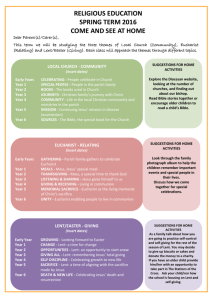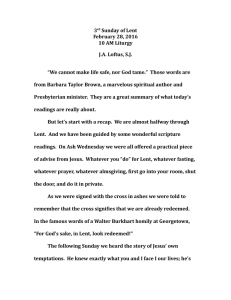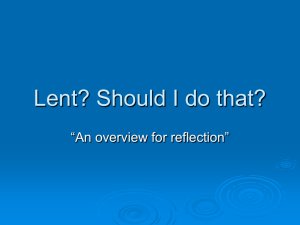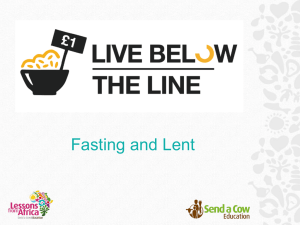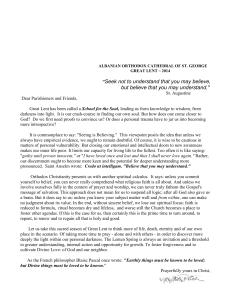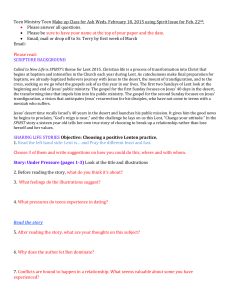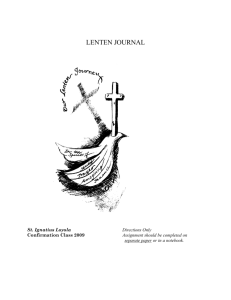View or print as a PDF - Congregation of Mark the Evangelist
advertisement
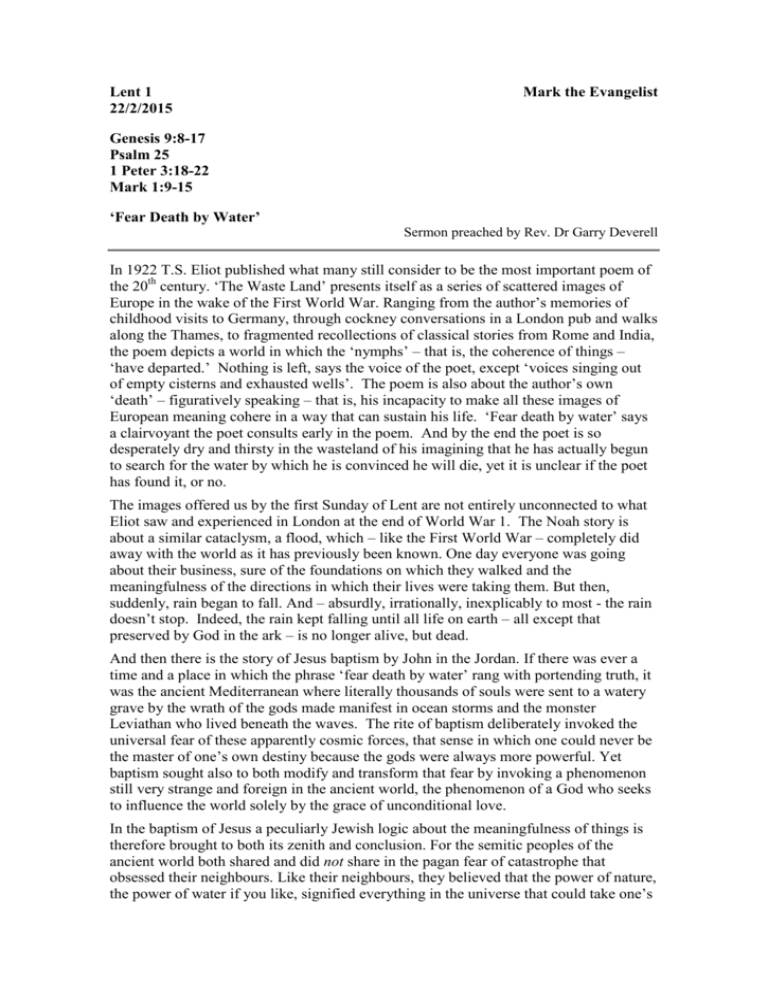
Lent 1 22/2/2015 Mark the Evangelist Genesis 9:8-17 Psalm 25 1 Peter 3:18-22 Mark 1:9-15 ‘Fear Death by Water’ Sermon preached by Rev. Dr Garry Deverell In 1922 T.S. Eliot published what many still consider to be the most important poem of the 20th century. ‘The Waste Land’ presents itself as a series of scattered images of Europe in the wake of the First World War. Ranging from the author’s memories of childhood visits to Germany, through cockney conversations in a London pub and walks along the Thames, to fragmented recollections of classical stories from Rome and India, the poem depicts a world in which the ‘nymphs’ – that is, the coherence of things – ‘have departed.’ Nothing is left, says the voice of the poet, except ‘voices singing out of empty cisterns and exhausted wells’. The poem is also about the author’s own ‘death’ – figuratively speaking – that is, his incapacity to make all these images of European meaning cohere in a way that can sustain his life. ‘Fear death by water’ says a clairvoyant the poet consults early in the poem. And by the end the poet is so desperately dry and thirsty in the wasteland of his imagining that he has actually begun to search for the water by which he is convinced he will die, yet it is unclear if the poet has found it, or no. The images offered us by the first Sunday of Lent are not entirely unconnected to what Eliot saw and experienced in London at the end of World War 1. The Noah story is about a similar cataclysm, a flood, which – like the First World War – completely did away with the world as it has previously been known. One day everyone was going about their business, sure of the foundations on which they walked and the meaningfulness of the directions in which their lives were taking them. But then, suddenly, rain began to fall. And – absurdly, irrationally, inexplicably to most - the rain doesn’t stop. Indeed, the rain kept falling until all life on earth – all except that preserved by God in the ark – is no longer alive, but dead. And then there is the story of Jesus baptism by John in the Jordan. If there was ever a time and a place in which the phrase ‘fear death by water’ rang with portending truth, it was the ancient Mediterranean where literally thousands of souls were sent to a watery grave by the wrath of the gods made manifest in ocean storms and the monster Leviathan who lived beneath the waves. The rite of baptism deliberately invoked the universal fear of these apparently cosmic forces, that sense in which one could never be the master of one’s own destiny because the gods were always more powerful. Yet baptism sought also to both modify and transform that fear by invoking a phenomenon still very strange and foreign in the ancient world, the phenomenon of a God who seeks to influence the world solely by the grace of unconditional love. In the baptism of Jesus a peculiarly Jewish logic about the meaningfulness of things is therefore brought to both its zenith and conclusion. For the semitic peoples of the ancient world both shared and did not share in the pagan fear of catastrophe that obsessed their neighbours. Like their neighbours, they believed that the power of nature, the power of water if you like, signified everything in the universe that could take one’s life away, everything that could render one’s plans and schemes both null and void, everything that could make a mockery of the notion that we are the masters of our own fate. Unlike their pagan neighbours, however, who were constantly seeking to do deals with the gods to secure their protection against catastrophe, the Hebrew preachers believed that the power behind all power was essentially both good and gracious, and desired nothing other than the good of the people, and desired this good unconditionally. The Hebrew stories about death by water were also, therefore, stories of LIFE by water. A flood comes to consume the earth and all its wickedness. Yet God preserves the seeds of a new world in an ark that floats upon the receding torrent for 40 days and 40 nights. The angel of death is sent to destroy all the firstborn of Egypt. Yet God’s people are preserved by walking through the depths of the Red Sea and trecking, for 40 years, through the wilderness until they cross into the land of their freedom via the Jordan river. Jesus’ life as a carpenter and compliant citizen of the Roman state is put to death in that same river by baptism that he might rise to live the life ordained for him by the God who claims him as his beloved Son. He receives, at that moment, the Spirit of God, who immediately drives him into the wilderness so that he can really learn what it means to do away with one’s own dreams and embrace the dreams of God. For 40 days and forty nights Jesus learns what it means to repent, to change one’s mind and heart, for the kingdom of God has come near. Friends, the 40 days and nights of Lent begin with these stories of death by water in order to set our course aright. 40 days and nights hence is the beginning of the paschal triduum, the Great Three Days which commemorate the fulfilment of Jesus own baptism, his death on the cross at the hands of evil powers, and his rising to life as a sign of God’s final triumph over such powers by the power of what we rightly call love. We look forward to this time because in Jesus’ rising is the possibility of our own rising. In Jesus’ triumph is the possibility of our own triumph. In Jesus victory is our own victory. Easter is therefore our goal and our destination. Yet, and this is very important, these stories of death by water also remind us that there can be no rising without a dying, there can be no prize without a willingness to give up on the very notion of winning, there can be no victory without a submission to complete and utter loss. For Lent is the process of getting to Easter by a dying to ourselves and a living to God. Lent is about confessing the truth about ourselves and our world, the truth of our utter helplessness to make for either sense or for good apart from a divinely given sensibility concerning the good. Lent is about the art of repentance and surrender, of turning from what is evil and giving ourselves only to what is beautiful and noble and true. Lent is about forsaking the business of getting by and learning to walk in the byways of God. It is about crying through the night and welcoming the joy of dawn. Lent, in short, is designed to kill everything in us that keeps us in chains so that God can free us, can redesign us, and fill our ‘empty cisterns’ with a new resonance for salvation. And we speak of these things in image and metaphor precisely because they are far too important to leave to prosaic, rational, flat language of the prevailing discourse. I pray you all a blessed and holy Lent. In the name of God . . . ***

